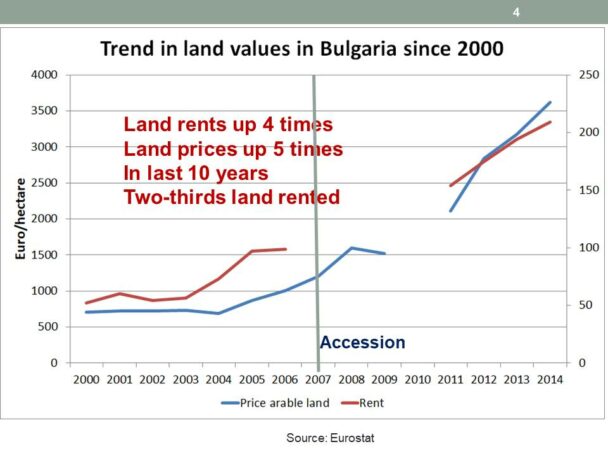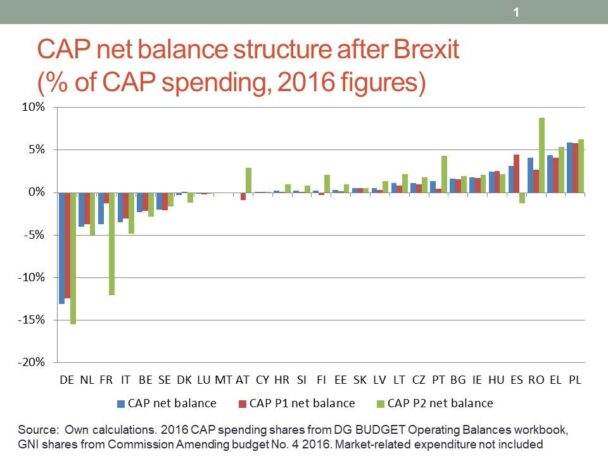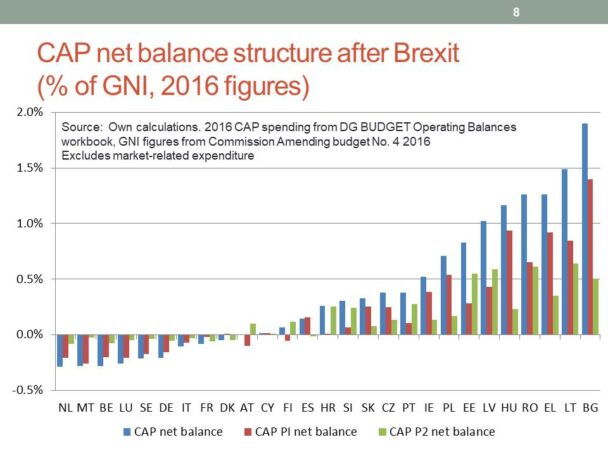This post reproduces my key-note statement to the session More efficient use of scarce financial resources – An efficient Common Agriculture Policy and focussed structural Funds at the European Political Strategy Centre High Level Conference ‘Shaping our Future: Designing the next Multiannual Financial Framework’ which was held 8-9 January 2018 in Brussels. The delivered version was slightly abbreviated for time reasons.
The session was intended to reflect on more efficient use of scarce financial resources in the EU budget’s two largest spending categories – agricultural policy and structural funds. I expected my fellow panellists to have a lot to say about structural funds, so my presentation focused on agricultural policy.
The factual background
First, some background figures. CAP spending commitments including the Rural Development Fund make up 38% of the current MFF, just ahead of economic, social and territorial cohesion at 34%.
71% of CAP spending is currently devoted to Pillar 1 direct payments, hectare-based payments to all farmers with eligible land. 24% of the CAP budget is allocated to Pillar 2 schemes under rural development programmes, with the remainder allocated to market-related expenditure.
The distribution of direct payments remains highly skewed. There are over 7.2 million beneficiaries of CAP direct payments across the EU. Most receive relatively small amounts. Figures for the 2014 claim year show that there were 131,300 farm holdings that each received more than €50,000 in direct payments. These farms received between them €13.8 billion. Thus, 33% of the direct payments budget, just less than 10% of the entire EU budget, is paid to a relatively small group of landowners. It is not clear what is the European value added of this expenditure.
The value added of direct payments
The Commission Communication on the future of food and farming after 2020 proposes that the future CAP would remain structured into two Pillars and that direct payments to farmers should continue. Direct payments make up an important share of farm income on many farms, particularly for grazing livestock. They represent a stable income stream in an industry exposed to considerable volatility. But they are not well-designed or well-targeted for these purposes.
Much of the benefit is capitalised into land values. It is hard to see this in the older Member States that have had agricultural support payments for decades, but it can be clearly seen in the evolution of land rents and prices in Bulgaria once that country was expected to adopt the CAP after accession in 2007. Land prices and rents rose four to five times in a ten-year period as CAP payments were phased in. Higher land values benefit non-farmers or those leaving the industry and make access for young farmers more difficult.
In the long run, we should phase out hectare-based income support payments. But this cannot be done overnight, and in any case the Communication foresees a continued role for direct payments in the next MFF. So we need to reflect on what the MFF should say about direct payments.
The Communication recognises the need to limit payments to the largest beneficiaries. It proposes various solutions including compulsory capping. The next MFF should at least make clear that there is no European value added in making income support payments to farms that are already well-structured and enjoy significant economies of scale. Whether the threshold for capping should be the same in each Member State merits further discussion.
Capping, in any case, is a second best solution. Capping is likely to lead to the artificial division of larger farms, and may slow down structural change. But as long as direct payments are justified as a form of income support, it is the lesser of two evils.
Distribution between Pillars
Continuing with the two-Pillar structure leaves open the question what should be the relative size of the Pillars in the next MFF. There are significant differences in the relative shares of the two Pillars between Member States. Pillar 2 shares range from less than 10% in Denmark to more than 70% in Malta.
The budget devoted to Pillar 1 direct payments is derived from the formulae used to calculate the compensation to farmers for reductions in support price guarantees in the two decades after 1992 (for the older Member States) plus the amounts negotiated for the newer Member States on their accession. For the older Member States, Commissioner Fischler decoupled these payments in the 2003 CAP reform but did not alter their magnitude. The current envelope for Pillar 1 direct payments reflects the path-dependence of EU agricultural policy rather than any objective demonstration of need. In the last MFF, the European Council made the decision to hold the size of these payments constant in nominal terms. However, it also gave Member States some flexibility to shift funds between Pillars if they desired.
The distribution between Pillars boils down to the relative priority to be given to straightforward income support compared to assisting farmers to meet the challenges of adopting new technologies, achieving more ambitious environmental goals, transforming to more sustainable production models, building farm resilience and improving the quality of life in rural areas. In the current MFF, greater cuts were made in Pillar 2 spending in order to maintain Pillar 1 spending in constant nominal terms. What should be the basis for this division in the next MFF? In principle, a higher share of EU money should be used on these more targeted interventions designed to overcome specific market failures.
Previous MFFs have also made use of maximum and minimum spending limits on particular policy instruments. The new delivery model set out in the CAP Communication is built around Member States setting targets for both Pillar 1 and Pillar 2 payments within the context of an overall CAP strategic plan which must be approved by the Commission. The logic would seem to be that Member States should be able to use the totality of CAP funding in the most appropriate way to meet the targets that they set.
Such a scenario has the danger that Member States would opt to concentrate funding on a set of easily-delivered targets with low transactions costs, such as either coupled or decoupled direct payments. There will thus be a need to introduce some restrictions on the relative spending on different targets and instruments to try to maximise the contribution to European value added. Some limits could already be introduced in the MFF (as, for example, the requirement to spend 30% of Pillar 1 direct payment ceilings on the greening payment in the current MFF) while others will be left to the CAP basic regulations.
The Communication acknowledges that the greening payment introduced in the last reform has not been a success. One option is to transfer this money to Pillar 2 where it could be used more effectively to achieve the EU’s environmental targets. The Communication suggests that the greening payment would be used, in conjunction with cross-compliance, to fund a menu of voluntary and mandatory environmental and climate interventions designed by Member States to suit their conditions chosen from an overall menu set out in the basic Regulation. Farmers would have to participate in these shallow or entry-level agri-environment-climate schemes in order to receive basic income support.
The move away from the prescriptive one-size-fits-all approach of the three greening practices is welcome. The problem is how to ensure that the measures designed by Member States and offered to farmers are meaningful in terms of environmental ambition and not simply a cover for disguised income support. Carefully designing the overall menu defined in the basic Regulation is one safeguard, but experience shows that, once the budget is secured, the co-legislature has a huge temptation to water down the requirements. The Communication suggests that the need to define quantified targets that will achieve the agreed environmental and climate targets at EU level will provide the required incentive. We discuss some ways in which the MFF could be designed to support this objective.
Co-financing Pillar 1 direct payments
In the context of the new delivery model, and given that limits on expenditure shares can be introduced in the basic CAP regulations, the traditional division between Pillar 1 and Pillar 2 of the CAP no longer plays a policy role. The sole justification for its survival in the CAP Communication appears to be that it demarcates the line between funds that are 100% financed by the EU and those that are co-financed.
Introducing co-financing of Pillar 1 payments was an idea raised in the Commission Reflection Paper on the future of EU finances. Although it was explicitly ruled out in an early draft of the CAP Communication, that paragraph was removed in the final version, suggesting the idea is still on the table. Co-financing would bring benefits in terms of a more efficient use of EU funds in a number of ways.
First, Member State contributions give them an incentive to maximise the value of spending compared to transfers financed 100% by Brussels. This justification for co-financing assumes Member States have choices over how this money is spent. Some flexibility in the design of Pillar 1 payments was introduced in the last reform, and this flexibility will be extended under the new delivery model proposed in the CAP Communication, especially where greening is concerned.
Second, assuming the two-Pillar structure of the CAP is maintained, co-financing would remove the anomaly between Pillar 1 and Pillar 2 spending and put spending in the two Pillars on an equal footing.
Third, co-financing allows the EU to use its budget to drive Member State expenditure in the direction of priorities with higher European value added. Co-financing rates would, as at present, be differentiated by Member State level of development but could also be adjusted to reflect European value added. Voluntary coupled payments, for example, which have no European value added, might be financed entirely by Member States (subject to rules set down in the CAP) whereas area payments for organic farmers or for environmentally sensitive permanent grasslands might receive higher EU co-financing than the norm.
Fourth, co-financing would release funds in the general EU budget which could be used for other EU priorities.
Allocating CAP funds between Member States
Both the division of the CAP budget in the MFF between Pillars and co-financing impact on the net CAP transfers received or paid by Member States which is always a sensitive topic. The political difficulties are shown on the next two slides.
The first compares the share in CAP Pillar 1 and Pillar 2 receipts of each Member State with its share in EU Gross National Income in 2016 assuming the UK were no longer a member. Countries are divided into three equal groups – net contributors on the left, those relatively unaffected by the CAP in the middle, and the net beneficiaries on the right.
In some cases, the amounts are small because the countries are small. Expressing net balances as a per cent of GNI makes clearer the distribution of net contributors and net beneficiaries. On this basis, around one-third of Member States are net contributors to the CAP budget, while two-thirds are net beneficiaries.
CAP funds, like the structural funds, are pre-allocated to Member States in the MFF so it is necessary to decide on an allocation key. For Pillar 1 direct payments in the last MFF, a process of ‘external convergence’ towards uniform payments per eligible hectare across Member States was agreed. The CAP Communication proposes that this process would be further continued for direct payments in the next MFF period.
No objective basis for the distribution of Pillar 2 payments exists. As for cohesion funding, the development of objective indicators on which to base the allocation of CAP funds between Member States remains a challenge.
Assuming one has found the ‘right’ allocation for Pillar 2 payments between Member States, it makes no sense to allow money from capping direct payments in Pillar 1 to be moved to Pillar 2 in the same country, as happens under present rules. Instead, land on individual farm holdings above a certain size should be excluded from a country’s eligible area and should not be counted when calculating a country’s entitlement to basic income support payments in the first place. These farms, instead, should be encouraged to seek funding under other CAP instruments for the uptake of technology, improved land management and strengthened resilience.
A budget for results
The new delivery model proposed in the CAP Communication would give Member States a lot more flexibility to design the specific measures to be funded under the CAP within the context of a CAP strategic plan covering both Pillars. Objectives would be set at EU level as well as a menu of policy interventions. Target setting and the choice of policy interventions would be left to Member States.
In this situation, there is the potential for conflict between the level of ambition that Member States set for themselves and their ability to draw down pre-allocated CAP funds. The priority in most cases will be the drawing down of funds, especially where they are 100% financed by the EU. Member States have a huge incentive to make that as easy as possible by setting targets as low as possible.
The Commission is placed in the impossible position, when approving the CAP strategic plans, of fighting an uphill battle to persuade Member States to be more ambitious. Even if Member States reluctantly agree to more ambitious targets, it is not clear if there will be repercussions if these targets are not met. The incentive structure, with pre-allocated funds which Member States see as ‘their’ money, is all wrong.
Member States should be incentivised to achieve better results with EU money in various ways. The use of differentiated co-financing rates has already been mentioned. Some of their budgets might be put into a performance reserve to be redistributed in the light of actual outcomes. Some of the CAP budget might not be pre-allocated but used to finance projects selected on a competitive basis from those submitted by regions and Member States. There could be a requirement for ex ante conditionalities to ensure that the conditions are in place to make best use of EU money.
As in all cases of performance-based budgeting, the choice of indicators by which to measure results will be critical. We must avoid the use of input indicators such as the proportion of budgets spent. Ideally, indicators should reflect the results achieved, but we may need to recognisee that it can be hard to move beyond outturn indicators to measuring what is really happening to outcomes. This is, in part, because of the long time lags in agriculture between interventions and outcomes, and in part because even well designed interventions may not achieve their intended outturns and outcomes because of the role played by extraneous events such as weather, disease or market conditions.
Conclusions – towards a more efficient CAP
The CAP Communication provides a promising basis on which to start deliberations on the future CAP. The beneficiaries of CAP funds will argue for the maintenance of the CAP budget, of course, that is what we would expect. We need to focus on how the next MFF can better support the objectives of ensuring European value added and a budget focused on results.
In the context of CAP strategic plans covering both Pillar 1 and Pillar 2, there is no longer a policy rationale to maintain the two-Pillar structure. Whether or not the Pillar structure is retained, the relative importance of spending on what we now call rural development issues should be increased compared to income support. Payments to larger beneficiaries should be limited allowing national top-ups if desired. Co-financing should be introduced for Pillar 1 payments as for all structural fund spending.
Turning the greening payment into a menu-based environment-climate scheme makes sense, provided the menu options make a genuine contribution to environmental improvement – here again co-financing gives the Commission a tool to steer Member States in a more ambitious direction. A proportion of CAP funds should not be pre-allocated but distributed on the basis of good performance and/or competitive funding. These are just some ways in which the next MFF could support a more efficient CAP.
The slides accompanying the presentation can be viewed here.
This post was written by Alan Matthews






